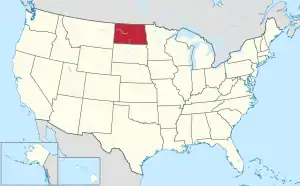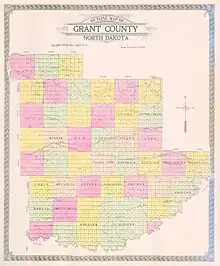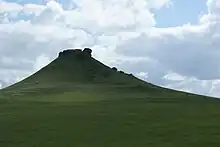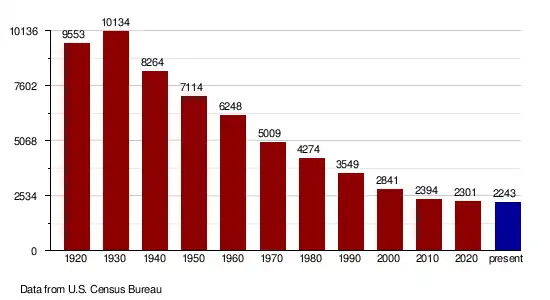Grant County | |
|---|---|
 | |
 Location within the U.S. state of North Dakota | |
 North Dakota's location within the U.S. | |
| Coordinates: 46°22′N 101°38′W / 46.36°N 101.64°W | |
| Country | |
| State | |
| Founded | 1916 |
| Named for | Ulysses S. Grant |
| Seat | Carson |
| Largest city | Elgin |
| Area | |
| • Total | 1,666 sq mi (4,310 km2) |
| • Land | 1,659 sq mi (4,300 km2) |
| • Water | 6.8 sq mi (18 km2) 0.4% |
| Population (2020) | |
| • Total | 2,301 |
| • Estimate (2022) | 2,243 |
| • Density | 1.4/sq mi (0.53/km2) |
| Time zone | UTC−7 (Mountain) |
| • Summer (DST) | UTC−6 (MDT) |
| Congressional district | At-large |
| Website | www |
Grant County is a county in the U.S. state of North Dakota. As of the 2020 census, the population was 2,301.[1] Its county seat is Carson.[2]
History
The territory of Grant County was part of Morton County until 1916. On November 7 the county voters determined that the SW portion of the county would be partitioned off to form a new county, to be named after Ulysses S. Grant, the US President from 1869 to 1877. Accordingly, the county government was organized on November 28, with Carson as the seat. The county's boundaries have remained unchanged since its creation.[3][4][5]

Geography

The Heart River flows eastward through the upper part of Grant County, and Cedar Creek flows east-northeastward along the county's southern boundary line. The county terrain consists of isolated hills among rolling hills, carved by drainages. The semi-arid ground is partially devoted to agriculture.[6] The terrain slopes to the east and south; its highest point is a rise near its southwestern corner, at 2,680 ft (820 m) ASL.[7] The county has a total area of 1,666 square miles (4,310 km2), of which 1,659 square miles (4,300 km2) is land and 6.8 square miles (18 km2) (0.4%) is water.[8] Lake Tschida, a Bureau of Reclamation reservoir and recreation area on the Heart River, is the county's largest body of water.[9]
The southwestern corner of North Dakota observes Mountain Time (Adams, Billings, Bowman, Golden Valley, Grant, Hettinger, Slope, and Stark counties). The counties of McKenzie, Dunn, and Sioux counties are split, with the western portions of each observing Mountain Time.
Major highways
Adjacent counties
- Morton County - northeast (observes Central Time)
- Sioux County - south
- Adams County - southwest
- Hettinger County - west
- Stark County - northwest
Protected areas
Source:[6]
- Cedar River National Grassland (part)
- Heart Butte River State Game Management Area
- Otter Creek State Game Management Area
- Pretty Rock National Wildlife Refuge
- Sheep Creek Dam State Recreation Area
Lakes
Source:[6]
- Pretty Rock Lake
- Sheep Creek Dam
- Lake Tschida
Demographics
| Census | Pop. | Note | %± |
|---|---|---|---|
| 1920 | 9,553 | — | |
| 1930 | 10,134 | 6.1% | |
| 1940 | 8,264 | −18.5% | |
| 1950 | 7,114 | −13.9% | |
| 1960 | 6,248 | −12.2% | |
| 1970 | 5,009 | −19.8% | |
| 1980 | 4,274 | −14.7% | |
| 1990 | 3,549 | −17.0% | |
| 2000 | 2,841 | −19.9% | |
| 2010 | 2,394 | −15.7% | |
| 2020 | 2,301 | −3.9% | |
| 2022 (est.) | 2,243 | [10] | −2.5% |
| U.S. Decennial Census[11] 1790-1960[12] 1900-1990[13] 1990-2000[14] 2010-2020[1] | |||
2020 census
As of the census of 2020, there were 2,301 people.
2010 census
As of the census of 2010, there were 2,394 people, 1,128 households, and 694 families in the county. The population density was 1.4 inhabitants per square mile (0.54/km2). There were 1,690 housing units at an average density of 1.02 units per square mile (0.39/km2). The racial makeup of the county was 97.2% white, 1.1% American Indian, 0.1% Asian, 0.2% from other races, and 1.3% from two or more races. Those of Hispanic or Latino origin made up 0.3% of the population. In terms of ancestry, 66.6% were German, 14.0% were Norwegian, 12.5% were Russian, 5.9% were Irish, 5.5% were English, and 2.2% were American.
Of the 1,128 households, 19.6% had children under the age of 18 living with them, 54.7% were married couples living together, 3.9% had a female householder with no husband present, 38.5% were non-families, and 36.5% of all households were made up of individuals. The average household size was 2.10 and the average family size was 2.72. The median age was 51.7 years.
The median income for a household in the county was $39,500 and the median income for a family was $53,542. Males had a median income of $33,750 versus $27,303 for females. The per capita income for the county was $25,840. About 7.3% of families and 13.0% of the population were below the poverty line, including 18.1% of those under age 18 and 18.7% of those age 65 or over.
Population by decade

Communities
Cities
- Carson (county seat)
- Elgin
- Leith
- New Leipzig
Census-designated places
Unincorporated communities
Townships
- Elm
- Fisher
- Freda
- Howe
- Lark
- Leipzig
- Minnie
- Pretty Rock
- Raleigh
- Rock
- Winona
Defunct township
- Otter Creek Township[15]
Politics
Grant County voters have traditionally voted Republican. In no national election since 1936 has the county selected the Democratic Party candidate.
| Year | Republican | Democratic | Third party | |||
|---|---|---|---|---|---|---|
| No. | % | No. | % | No. | % | |
| 2020 | 1,145 | 82.91% | 207 | 14.99% | 29 | 2.10% |
| 2016 | 1,108 | 80.23% | 185 | 13.40% | 88 | 6.37% |
| 2012 | 1,025 | 72.54% | 334 | 23.64% | 54 | 3.82% |
| 2008 | 873 | 64.91% | 405 | 30.11% | 67 | 4.98% |
| 2004 | 952 | 76.65% | 264 | 21.26% | 26 | 2.09% |
| 2000 | 1,077 | 75.47% | 235 | 16.47% | 115 | 8.06% |
| 1996 | 760 | 55.51% | 300 | 21.91% | 309 | 22.57% |
| 1992 | 900 | 45.94% | 415 | 21.18% | 644 | 32.87% |
| 1988 | 1,351 | 66.13% | 654 | 32.01% | 38 | 1.86% |
| 1984 | 1,607 | 74.92% | 507 | 23.64% | 31 | 1.45% |
| 1980 | 1,891 | 80.85% | 317 | 13.55% | 131 | 5.60% |
| 1976 | 1,205 | 53.37% | 952 | 42.16% | 101 | 4.47% |
| 1972 | 1,569 | 70.17% | 596 | 26.65% | 71 | 3.18% |
| 1968 | 1,648 | 71.78% | 488 | 21.25% | 160 | 6.97% |
| 1964 | 1,421 | 57.11% | 1,063 | 42.73% | 4 | 0.16% |
| 1960 | 1,794 | 65.21% | 955 | 34.71% | 2 | 0.07% |
| 1956 | 1,872 | 72.03% | 718 | 27.63% | 9 | 0.35% |
| 1952 | 2,465 | 85.32% | 403 | 13.95% | 21 | 0.73% |
| 1948 | 1,555 | 66.94% | 689 | 29.66% | 79 | 3.40% |
| 1944 | 1,745 | 80.64% | 410 | 18.95% | 9 | 0.42% |
| 1940 | 2,815 | 81.52% | 627 | 18.16% | 11 | 0.32% |
| 1936 | 1,022 | 29.57% | 1,858 | 53.76% | 576 | 16.67% |
| 1932 | 657 | 17.98% | 2,912 | 79.69% | 85 | 2.33% |
| 1928 | 1,759 | 54.59% | 1,434 | 44.51% | 29 | 0.90% |
| 1924 | 1,120 | 39.07% | 125 | 4.36% | 1,622 | 56.57% |
| 1920 | 2,184 | 83.17% | 296 | 11.27% | 146 | 5.56% |
See also
References
- 1 2 "State & County QuickFacts". United States Census Bureau. Retrieved April 6, 2023.
- ↑ "Find a County". National Association of Counties. Archived from the original on May 31, 2011. Retrieved June 7, 2011.
- ↑ Long, John H. (2006). "Dakota Territory, South Dakota, and North Dakota: Individual County Chronologies". Dakota Territory Atlas of Historical County Boundaries. The Newberry Library. Archived from the original on November 11, 2007. Retrieved February 19, 2019.
- ↑ Certification of the division of Morton County, ND 28 November 1916Archived July 3, 2008, at the Wayback Machine
- ↑ "County History". North Dakota.gov. The State of North Dakota. Archived from the original on February 2, 2015. Retrieved February 19, 2019.
- 1 2 3 4 5 Grant County ND Google Maps (accessed February 19, 2019)
- ↑ ""Find an Altitude/Grant County ND" Google Maps (accessed February 19, 2019)". Archived from the original on May 21, 2019. Retrieved February 20, 2019.
- ↑ "2010 Census Gazetteer Files". United States Census Bureau. August 22, 2012. Archived from the original on January 29, 2015. Retrieved January 28, 2015.
- ↑ "Heart Butte Reservoir". Recreation.gov. Bureau of Reclamation. Retrieved June 3, 2010.
- ↑ "Annual Estimates of the Resident Population for Counties: April 1, 2020 to July 1, 2022". Retrieved April 6, 2023.
- ↑ "U.S. Decennial Census". United States Census Bureau. Retrieved January 28, 2015.
- ↑ "Historical Census Browser". University of Virginia Library. Archived from the original on August 11, 2012. Retrieved January 28, 2015.
- ↑ Forstall, Richard L., ed. (March 27, 1995). "Population of Counties by Decennial Census: 1900 to 1990". United States Census Bureau. Retrieved January 28, 2015.
- ↑ "Census 2000 PHC-T-4. Ranking Tables for Counties: 1990 and 2000" (PDF). United States Census Bureau. April 2, 2001. Archived (PDF) from the original on March 27, 2010. Retrieved January 28, 2015.
- ↑ "Geographic Change Notes for North Dakota". United States Census Bureau. Archived from the original (TXT) on October 10, 2012. Retrieved June 17, 2010.
- ↑ Leip, David. "Atlas of US Presidential Elections". uselectionatlas.org. Retrieved April 12, 2018.
Further reading
Kane, Joseph Nathan; Charles Curry Aiken (2004). The American Counties: Origins of County Names, Dates of Creation, and Population Data, 1950-2000. Scarecrow Press. p. 116. ISBN 0-8108-5036-2.
External links
- Grant County Official website
- Grant County maps, Sheet 1 (northern) and Sheet 2 (southern), North Dakota DOT
